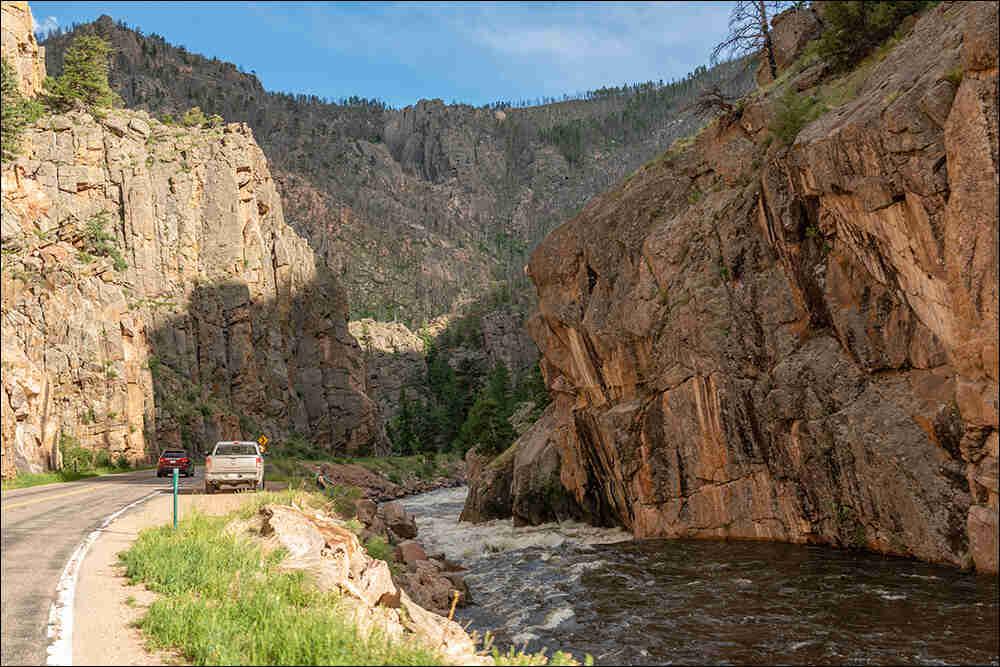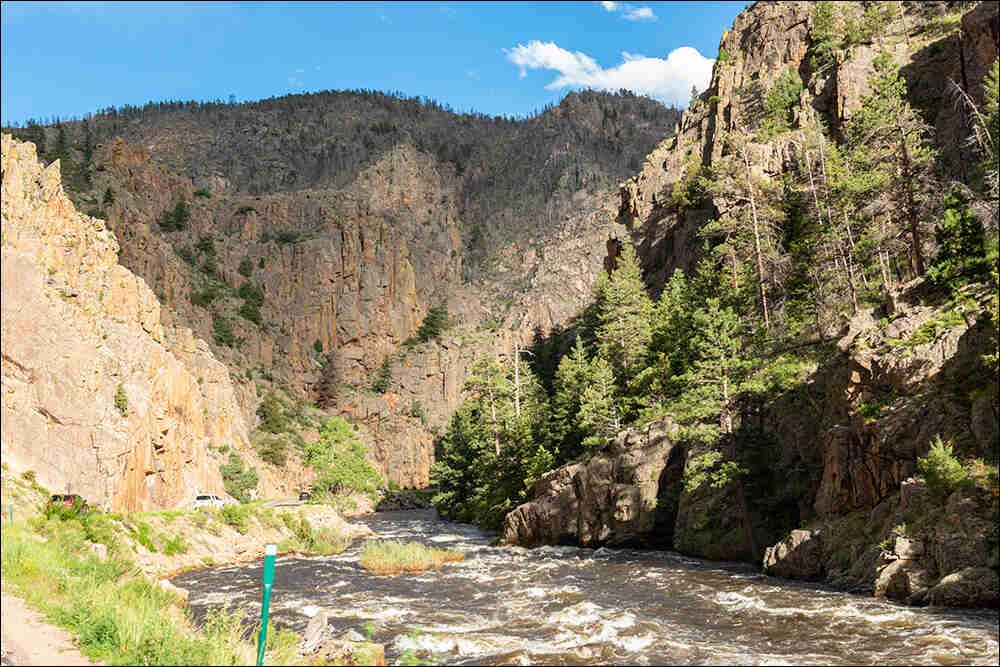Cache la Poudre River
Full Article
Rising in Rocky Mountain National Park and coursing 126 miles to its junction with the South Platte River near Greeley, the Cache la Poudre River is the lifeblood of several northern Colorado communities and contributes significantly to the economy of the region. Today, those who live in the Poudre watershed seek to balance the work of the river with restoration of its health.
From the water conflicts of the 1870s that helped solidify the “first-in-time, first-in-right” doctrine to recreational development in the 1980s, past and present residents of the Poudre watershed have made important contributions to western water law and the evolution of highly complex water delivery systems.
Description
The Cache la Poudre River flows east from the Continental Divide in the northern Front Range of Colorado, originating in the high alpine tundra at Poudre Lake near Milner Pass. From there, it runs through the Poudre River Canyon, a stretch of territory that was designated as Colorado’s first National Wild and Scenic River in 1986. Here, the river is flanked by majestic cliffs and intriguing rock formations enveloped in pine, sagebrush, mountain mahogany, and aspen. State Highway 14 runs through the canyon, providing easy access to the river’s scenic and recreational opportunities. Rapids on the river’s upper reaches support an active rafting season, which generally runs from May through August. The Poudre spills out of the canyon onto the plains near Laporte. Once on the plains, it travels for approximately forty-five miles through the communities of Fort Collins, Windsor, and Greeley before joining the South Platte about five miles east of Greeley.
Local residents and longtime visitors affectionately refer to the river as “the Poudre” (pronounced “POO-der”). Among several stories that claim to explain the origins of the river’s name, the most prominent holds that in the early 1800s, French trappers camped at the mouth of the canyon, just west of Fort Collins. When a heavy snow fell and they had to reduce their load, the Frenchmen buried their gunpowder along the river’s banks, giving it the name “Cache la Poudre,” or “hiding place of the powder.”
Human Interaction
Indigenous people relied on the Cache la Poudre for thousands of years, from the ancient Paleo-Indians who left scattered remains at the Lindenmeier Folsom site to the Ute and Arapaho people who met the first Europeans and Anglo-Americans. Before the arrival of settlers in the 1860s, the Arapaho, Cheyenne, and Ute people valued the river as a good place to hunt and gather roots, cattails, and chokecherries. For hundreds of years, nomadic tribes occupied the river valley on a seasonal basis.
Aside from the impacts of intentional fires, Native Americans generally left the river undisturbed. However, white settlers and water leaders who came after them sought to manipulate the river for optimal human benefit. In the process, they made outsized contributions to water management in arid and semiarid lands. Major water leaders in Colorado included Benjamin Eaton, a homesteader, canal builder, and governor; Elwood Mead, an educator and international water expert; Delph Carpenter, who brokered interstate water agreements and was an attorney for the Greeley-Poudre Irrigation District; Ralph Parshall, inventor of the Parshall Flume, a device that measures water flow; and W. D. Farr, a rancher, businessman, and supporter of supplemental water delivery to Northern Colorado.
Although the Poudre basin itself yielded only modest ore during the Colorado Gold Rush of the late 1850s, the influx of prospectors created a steady market for hay, grains, and other agricultural products. As a result, farming proved to be the most viable occupation for those living near the river. As early settlers moved into the Poudre Valley, their first response to the dry conditions was to build modest irrigation ditches, usually serving one farm. The farms were located on low-lying bottomland to make irrigation easier. When the settlers of the Union Colony of Greeley arrived in 1870, they planned large-scale irrigation ditches that served many farms. By 1876, the Greeley Number Two Canal was thirty-six miles long and twenty-two feet wide. The Union colonists were the first farmers in Colorado to extend irrigation works beyond the bottomlands, putting more local prairie into production.
In 1873, using expertise from Greeley, the Fort Collins Agricultural Colony began building large irrigation canals, such as the Lake Canal. During the hot summer of 1874, Greeley farmers noted that the newer canals drained much of the Poudre’s flow, leaving little for downstream users. The Greeley farmers, who had built their canals first, felt cheated as their crops withered and trees wilted. Farmers from all along the river met at the Whitney Schoolhouse near today’s Windsor. After heated discussions and an agreement on a temporary solution, farmers collectively acknowledged the need for a well-defined water law.
Greeley irrigators led the effort to include the doctrine of prior appropriation in the 1876 Colorado Constitution. Holders of “junior” water rights—in this case the Lake Canal users—could not take water until holders of “senior” claims—the Greeley farmers—received sufficient water to meet their needs. Colorado became the first state to adopt prior appropriation, which became known as the “Colorado Doctrine.” This water appropriation system has since prevailed throughout the American West in a variety of forms.
The river’s importance for irrigation made the Poudre a prominent subject of the nation’s first irrigation curriculum, taught by Elwood Mead at the State Agricultural College (now Colorado State University) in Fort Collins during the 1880s. A competent engineer and future director of the federal Bureau of Reclamation, Mead once observed that “the irrigated district watered by the Poudre River of Colorado is not surpassed by any other in either the intelligence of its irrigators or the excellence of the methods employed in the distribution of water from the stream.”
Multiple Uses
As northern Colorado’s economy diversified in the twentieth century, its principal river became a “hardworking” river, serving the needs of not only farmers but also urban residents, industrialists, and recreationalists. Searing drought of the 1930s accentuated the need for a more dependable supply of water. Poudre River residents lobbied for federal help in the form of a supplemental water supply system, the Colorado–Big Thompson Project (CBT). Completed in 1956, the project brought water from the headwaters of the Colorado River on the western side of the Continental Divide to the Poudre and other rivers along the Front Range. The extra water supplied through the CBT helped attract new people and industries to northern Colorado, such as Woodward Governor, Hewlett Packard, and Kodak. The technology, tourism, and service industries, and the cities they supported, competed with the agricultural sector for the Poudre’s water.
By the 1960s, traditional agricultural and urban water rights consumed most of the available water in the Poudre River, and society was demanding water for sustained ecosystem health and providing recreational opportunities. To help protect both river ecosystems and the recreation industry, the Colorado legislature created minimum in-stream flow water rights in 1973 and established in-channel diversion water rights for recreation businesses in 2002.
In the latter decades of the twentieth century, water users in the Poudre Valley clashed over pollution in the river from new industries and growing cities. They also fought over new storage proposals such as the Gray Rock Dam on the main stem of the Poudre River, and the protection of minimum stream flows. Additionally, in the 1980s the city of Thornton began to acquire rights to Poudre River water to support its expanding population. As of 2016, the city is developing plans for a pipeline to carry that water some sixty miles from the river. As the twentieth century turned into the twenty-first, farmers, cities, industries, recreationalists, and environmentalists began hashing out agreements that will result in using the Poudre’s water in new ways that reflect the values of the changing population.
Cache La Poudre River National Heritage Area
In 1996 the US Congress designated some forty-five miles of the lower Poudre River as the Cache la Poudre River National Heritage Area. The National Park Service describes National Heritage Areas as “places where natural, cultural, and historic resources combine to form a cohesive, nationally important landscape.” The Cache la Poudre River National Heritage Area, which the park service abbreviates as CALA, certainly fits this description.
CALA stretches from the border of the Arapaho-Roosevelt National Forest northwest of Fort Collins to the river’s confluence with the South Platte River east of Greeley. With funding and technical assistance from the National Park Service, CALA is managed by the Poudre Heritage Alliance, a local nonprofit organization that represents Weld and Larimer Counties, cities and towns along the river, water districts, education, agriculture, and at-large members. CALA commemorates the river’s contributions to the development of water law and water delivery systems in the United States. As historian Dan Tyler notes, “the Poudre River has provided an excellent example of how an evolving western community can learn to cope with changing pressures on its principal source of water.”
The Poudre River Trail follows most of the lower river, permitting a streamside view of the workings of the river, as well as the restoration efforts underway. Recent restoration efforts include thirty-one acres of the new Woodward Campus devoted to the restoration of river ecosystem and the removal of the Josh Aims diversion structure.
The trail also provides access to key historical sites, including the field laboratory near Bellvue, where Ralph Parshall conducted field tests of his flume in the 1920s, as well as the “boat chute,” which was important to creation of the first in-stream recreational water right in the 1990s. Local water history is also highlighted in area museums, such as the Greeley Museum, Centennial Village Museum in Greeley, the Museum of Discovery in Fort Collins, the 1883 Fort Collins Water Works, and the Eaton House in Windsor. Through these and other resources, CALA continues to provide visitors and residents with an understanding of the sometimes harmonious, often adversarial relationship between nature and culture that shaped the American West.







